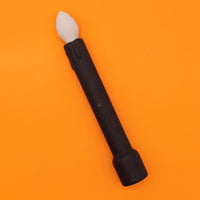Intimacy is joyful and life-sustaining. It is also inherently vulnerable. After all, even the most successful of relationships ends. Our lovers leave us, our feelings change, or we choose different paths. If we do stay with a lover our whole lives, death itself will eventually separate us. Intimacy is fraught with vulnerability, because to be human is to have a long-term relationship with loss. This poignancy sweetens experiences of genuine closeness: the wild glow of orgasm; the affirming confidence of an all-night talk. Yet there’s another way in which sexuality is vulnerable. This type of vulnerability is not inevitable, it’s not natural, and it’s not something we should have to experience. This is the societal pain and trauma that we are taught, often forced, to associate with intimacy, from slut shaming and impossible body standards to transphobia, racist fetishization, and sexual abuse. In a world that systematically devalues the love and labor of women, queer people, and people of color, sexual harm is, for most of us, ubiquitous. It affects women, trans, and nonbinary people at every level, from our increased risk of sexual assault and abuse—which can result in mental illness and homelessness—to gender disparities in how often we orgasm. Many of us are taught to associate shame with our sexualities, and to minimize our desires and our emotions. Or we are taught that our entire worth lies in our sexualities and our ability to find and “keep” a mate. As a result, we either avoid opening up altogether, or open up and find ourselves repeatedly burned.
Reclaiming our sensual power means allowing ourselves to be open to both intimacy and pain—intentionally allowing ourselves to be vulnerable.
This violently enforced vulnerability can disconnect us from our own sexualities, which we may be made to view as harmful, wrong, or degraded. In her classic essay Uses of the Erotic, Black lesbian feminist Audre Lorde argues that patriarchal, capitalist white supremacy requires us to disconnect from our erotic selves. “In order to perpetuate itself, every oppression must corrupt or distort those various sources of power within the culture of the oppressed that can provide energy for change,” writes Lorde. “For women, this has meant a suppression of the erotic as a considered source of power and information within our lives.” Oppression severs us from our sensuous wholeness, diverting our emotional energy into service of an unjust system, through, for example, underpaid care work. We are taught to neglect our instincts and disregard our intuitive connections to the sensory world. “As women, we have come to distrust that power which rises from our deepest and nonrational knowledge,” writes Lorde. The reason for this is simple. If we were truly in touch with our own power and pleasure, Lorde writes, we would fight like hell against anyone trying to exploit it: “Women so empowered are dangerous.” Reclaiming our sensual power means, in part, reconnecting to desire in all its fullness. It means learning to accept ourselves as we are, and embracing that we too are worthy of pleasure, connection, and joy, simply by merit of being human. And it means allowing ourselves to be open to experience both intimacy and pain—intentionally allowing ourselves to be vulnerable, within a system that already renders us vulnerable without our consent. I know: It sounds terrifying.
How do we bring our full selves through the door of intimacy and pleasure, in a world built to punish us for letting our guards down?
Vulnerability is terrifying. To be open to pleasure, intimacy, and love, in a world where our own sexualities are used against us, is an incredible act of courage. But it’s also part of the path to genuine connection and liberation, writes author, doula, and Black feminist adrienne maree brown. “I can’t leave any of myself at the door of love and expect the experiment of it to work,” brown writes. So how do we bring our full selves through the door of intimacy and pleasure, in a world built to punish us for letting our guards down? It’s the question that brought me crash-landing into a new therapist’s office a few years ago. Fresh out of an abusive relationship that strained my health and imploded my self-image, I was jumpy and weepy, wrung out as an old dress left to dry. I wanted intimacy, but entering the dating pool felt like entering a tub of sharks. “I just don’t know how I should be treated in relationships,” I sobbed to my therapist. “I don’t know what I deserve.” That’s part of how sexual harm works. When someone violates us, they send us the message that our sexualities are not worthy of respect, that we are not worthy of respect. When an entire society causes harm, the message of our own unworthiness can get baked into us at such a deep level, we often hardly notice it. Each of us has an internal compass, a gut sense pointing to the north of our own value. But hurt and discrimination alienate us from this compass. Because existing in our bodies is painful, because our needs are often neglected and delegitimized, we distance ourselves from the depth of our own desire. When intimacy knocks on our door, we may not know how to open it.
Vulnerability can look like finding your tenderness. But it can also look like finding your anger.
Therapist Gretchen Blycker, in a previous interview for Dame, said that this is partly due to trauma’s effect on our ability to hold healthy boundaries. Our sexualities are like a river, she said, and “when a river has definite boundaries, it can flow.” But when we’re harmed, this flow is interrupted. We may find it difficult to both take the risks required for sexual vulnerability, and take care of our own safety. As a result, we either pull our boundaries way in, or lack healthy boundaries entirely. “When we can’t identify our safe boundary, that’s a part of us that is always holding on,” said Blycker. “Or we’re overflowing, so we get hurt again.” When I walked into that therapist’s office a few years ago, those boundaries looked like floodplains. I had little trust in others; worse, I had little trust in myself. I didn’t know where to put the hurt, so it flowed from me like rain, muddying my perception of who I could trust to enter my physical and mental space. On the other side of the spectrum, many people overprotect themselves by pulling their boundaries in so tight, their river flow slows to a trickle, parching them of human connection. Whatever our response to trauma—whether we’re flooders or dam-builders—the result is the same: We’re not able to enter the vulnerable flow of genuine intimacy, with ourselves and others. A lot must change in society so that all of us, especially marginalized people, can choose vulnerability without fearing for our fundamental wellbeing and safety. We need structural change: an end to wealth inequality, to the prison industrial complex, to the homophobia and transphobia still built into our institutions. Yet even right now, we can love ourselves and trust ourselves enough to learn, ever so slowly, how to establish the healthy boundaries that allow us to embrace pleasure in a world hostile to our thriving. We tend to think of sexual vulnerability as the impulse to play fast and loose, to let it all hang out. Vulnerability can, indeed, look like that: the rain-soaked makeout; the impulsive skinny-dip; the one-time fuck in a bar bathroom. But vulnerability can also look like putting a toe into the water to check the temperature, and then, when it feels right, putting another toe, and then another one, until you’ve submerged your whole foot. Vulnerability can be a big, resounding yes. But it can also be opening enough to ourselves, and our feelings—even the inconvenient ones—to say no. Vulnerability can look like stripping the calluses of hurt away and finding your tenderness. But it can also look like finding your anger. Intimate vulnerability isn’t just individual. It is something we express every time we take risks to fight against those socially imposed barriers to our pleasure, by advocating for everyone’s right to bodily autonomy. Vulnerability can mean risking police abuse by marching in the streets; opening ourselves up to conflict by calling out harmful beliefs in our families; or confronting uncomfortable truths about our own privilege. However we find ourselves expressing it, this vulnerability is an act of profound, daring love. It’s a collective wager, not just that intimacy is worth the risk, but that our capacity for joy is deeper than the violence that tries to limit us.




















































